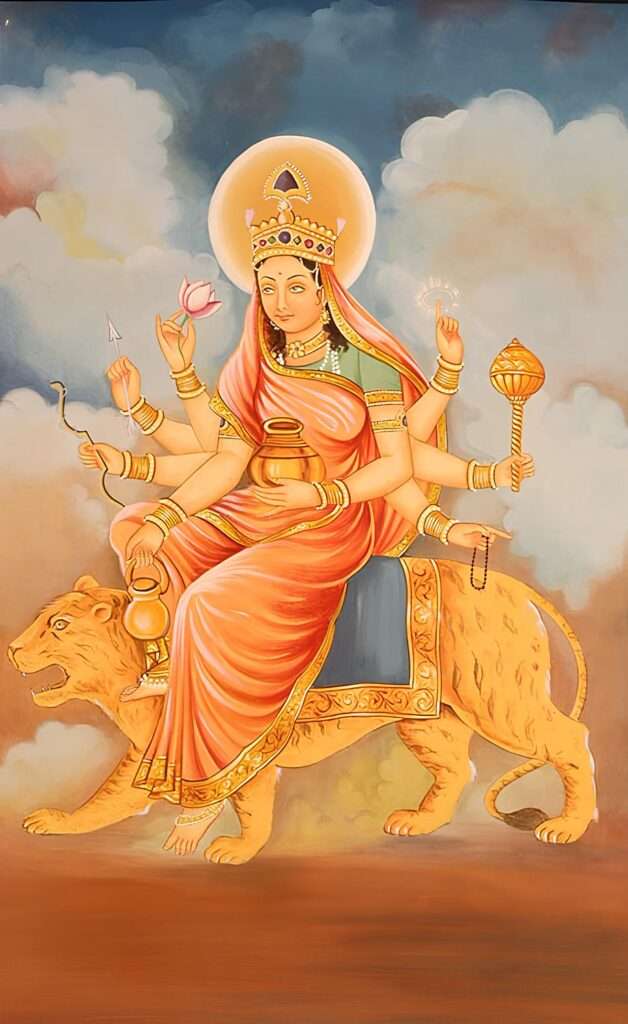Maa Kushmanda: The Divine “Creatrix” in Vedic Tradition

Maa Kushmanda, fourth of the nine forms of Goddess Durga worshipped during Navratri, is a powerful embodiment of the divine creative energy in Hindu tradition. Her name itself encapsulates her cosmic significance – “Ku” means little, “ushma” means warmth or energy, and “anda” means egg or universe. Thus, Kushmanda refers to the one who created the little cosmic egg or universe with her warmth and energy.
Vedic Origins
The Rigveda, the oldest of the four Vedas, contains hymns dedicated to goddesses like Aditi (the boundless one), Prithvi (the earth), and Ushas (the dawn), who are seen as manifestations of the primordial feminine energy. The Devi Sukta (Rigveda 10.125), one of the earliest references to the Supreme Goddess, describes her as the one who pervades all of creation and bestows wealth, victory, and wisdom upon her devotees. This hymn can be seen as a precursor to the later Indian traditions that worship the Divine Mother in various forms, including Kushmanda.
Puranic Accounts
The Divine description of Maa Kushmanda is elaborated in the Puranas, particularly the Devi Bhagavata Purana and the Markandeya Purana. According to these texts, when the universe was engulfed in darkness before creation, the Divine Mother smiled, and from her smile emanated the cosmic egg or Brahmanda. Kushmanda is thus seen as the Adi Shakti or primordial energy that sparked the creation of the universe. The Devi Bhagavata Purana associates her with the Anahata or heart chakra.
Devi Bhagavata Purana states: “She is the one who created the universe with her laughter. She dwells in the core of the sun and provides energy and direction to it. She bestows happiness, health, and prosperity upon her devotees.”

Iconography and Symbolism
In her iconography, Kushmanda is depicted as an eight-armed goddess sitting on a lion or tiger. Her eight arms hold various weapons and symbols, including a kamandalu (water pot), bow, arrow, lotus, pot of nectar, discus, mace, and a rosary. The weapons symbolize her power to destroy evil and protect her devotees, while the lotus and nectar represent her ability to bestow spiritual enlightenment and immortality. The lion or tiger she rides represents dharma or righteousness, and her radiant golden complexion is said to illuminate the entire universe. The eight arms also signify the eight siddhis (supernatural powers) and nine nidhis (treasures) that she grants to her devotees.
Kushmanda’s association with the Sun and the Anahata chakra highlights her role as the source of life, energy, and spiritual awakening. Just as the sun sustains life on earth, Kushmanda nourishes the universe with her divine energy. Her presence in the heart chakra indicates her ability to open up the heart to love, compassion, and devotion.
Worship and Significance
Kushmanda is worshipped on the fourth day of Navratri, which falls in the month of Ashwin (September-October). Devotees offer her red flowers, kumkum, and sweets like malpua and halwa. The main mantra chanted in her honor is “Om Devi Kushmandayai Namah”. Worshipping Kushmanda is believed to bestow good health, strength, prosperity, and spiritual enlightenment. She is especially invoked by those seeking to overcome obstacles, negativity, and inner darkness. By meditating on her form and chanting her mantra, devotees seek to awaken their inner divine energy and align themselves with the creative power of the universe.
In essence, Maa Kushmanda represents the divine creative force that underlies all of existence. She is the Adi Shakti or primordial energy that sparks the creation of the universe and sustains it with her warmth and light. By worshipping her, devotees seek to tap into this cosmic creative power and experience the fullness, abundance, and bliss of life.
As the Devi Bhagavata Purana beautifully states:Ya Devi Sarvabhuteshu Maa Kushmanda Rupena Samsthita
Namastasyai Namastasyai Namastasyai Namo Namah
Salutations to the Devi who abides in all beings in the form of Mother Kushmanda 🕉️
Salutations to her, salutations to her, salutations to her again and again.”By invoking Maa Kushmanda, we honor the divine creative power within ourselves and the universe, and seek to align ourselves with the eternal flow of energy, wisdom, and bliss that she represents. May her grace illuminate our hearts and guide us on the path of spiritual awakening.
